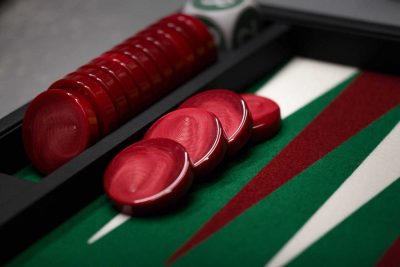Backgammon is a game for two players, played on a board consisting of twenty-four narrow triangles called points. The triangles alternate in color and are grouped into four quadrants of six triangles each. The quadrants are referred to as a player’s home board and outer board, and the opponent’s home board and outer board. The home and outer boards are separated from each other by a ridge down the center of the board called the bar.
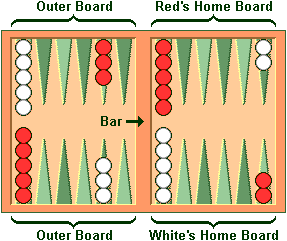
An alternate arrangement is the reverse of the one shown here, with the home board on the left and the outer board on the right.
The points are numbered for either player starting in that player’s home board. The outermost point is the twenty-four point, which is also the opponent’s one point. Each player has fifteen checkers of their own color. The initial arrangement of checkers is: two on each player’s twenty-four point, five on each player’s thirteen point, three on each player’s eight point, and five on each player’s six point.
Both players have their own pair of dice and a dice cup used for shaking. A doubling cube, with the numerals 2, 4, 8, 16, 32, and 64 on its faces, is used to keep track of the current stake of the game.

Explore more resources for new players. See our New to Backgammon collection of articles.
Object of the Game
The object of the game is to move all your checkers into your own home board and then bear them off. The first player to bear off all of their checkers wins the game
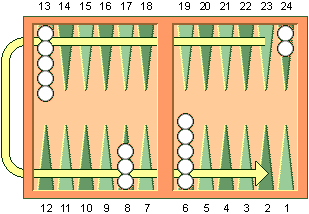
During the course of the game, a player who feels they have a sufficient advantage may propose doubling the stakes.
Movement of the Checkers
To start the game, each player throws a single die. This determines both the player to go first and the numbers to be played. If equal numbers come up, then both players roll again until they roll different numbers. The player throwing the higher number now moves their checkers according to the numbers showing on both dice. After the first roll, the players throw two dice and alternate turns.The roll of the dice indicates how many points, or pips, the player is to move their checkers. The checkers are always moved forward, to a lower-numbered point. The following rules apply:
- A checker may be moved only to an open point, one that is not occupied by two or more opposing checkers.
- The numbers on the two dice constitute separate moves. For example, if a player rolls 5 and 3, they may move one checker five spaces to an open point and another checker three spaces to an open point, or they may move the one checker a total of eight spaces to an open point, but only if the intermediate point (either three or five spaces from the starting point) is also open.
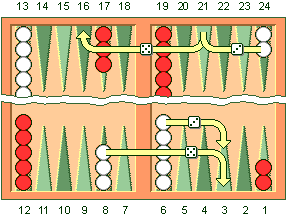
![[5]](http://www.bkgm.com/rules/wdie5.gif)
![[3]](http://www.bkgm.com/rules/wdie3.gif) .
.- A player who rolls doubles plays the numbers shown on the dice twice. A roll of 6 and 6 means that the player has four sixes to use, and they may move any combination of checkers they feel appropriate to complete this requirement.
- A player must use both numbers of a roll if this is legally possible (or all four numbers of a double). When only one number can be played, the player must play that number. Or if either number can be played but not both, the player must play the larger one. When neither number can be used, the player loses their turn. In the case of doubles, when all four numbers cannot be played, the player must play as many numbers as they can.
The object of the game is to move all your checkers into your own home board and then bear them off. The first player to bear off all of their checkers wins the game
Hitting and Entering
A point occupied by a single checker of either color is called a blot. If an opposing checker lands on a blot, the blot is hit and placed on the bar.Any time a player has one or more checkers on the bar, their first obligation is to enter those checker(s) into the opposing home board. A checker is entered by moving it to an open point corresponding to one of the numbers on the rolled dice. For example, if a player rolls 4 and 6, they may enter a checker onto either the opponent’s four point or six point, so long as the prospective point is not occupied by two or more of the opponent’s checkers.

Figure 4. If White rolls
![[6]](http://www.bkgm.com/rules/wdie6.gif)
![[4]](http://www.bkgm.com/rules/wdie4.gif) with a checker on the bar, they must enter the checker onto Red’s four point since Red’s six point is not open.
with a checker on the bar, they must enter the checker onto Red’s four point since Red’s six point is not open.If neither of the points is open, the player loses their turn. If a player is able to enter some but not all of their checkers, they must enter as many as they can and then forfeit the remainder of their turn. After the last of a player’s checkers has been entered, any unused numbers on the dice must be played, by moving either the checker that was entered or a different checker.
Bearing Off
Once a player has moved all of their fifteen checkers into their home board, they may commence bearing off. A player bears off a checker by rolling a number that corresponds to the point on which the checker resides, and then removing that checker from the board. Thus, rolling a 6 permits the player to remove a checker from the six point. If there is no checker on the point indicated by the roll, the player must make a legal move using a checker on a higher-numbered point. If there are no checkers on higher-numbered points, the player is permitted (and required) to remove a checker from the highest point on which one of thier checkers resides. A player is under no obligation to bear off if they can make an otherwise legal move.
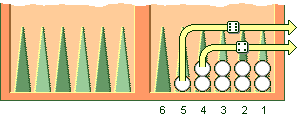
Figure 5. White rolls
![[6]](http://www.bkgm.com/rules/wdie6.gif)
![[4]](http://www.bkgm.com/rules/wdie4.gif) and bears off two checkers.
and bears off two checkers.A player must have all of their active checkers in their home board in order to bear off. If a checker is hit during the bear-off process, the player must bring that checker back to their home board before continuing to bear off. The first player to bear off all fifteen checkers wins the game
Doubling
Backgammon is played for an agreed stake per point. Each game starts at one point. During the course of the game, a player who feels they have a sufficient advantage may propose doubling the stakes. They may do this only at the start of thier own turn and before they have rolled the dice. A player who is offered a double may refuse, in which case they concede the game and pays one point. Otherwise, they must accept the double and play on for the new higher stakes. A player who accepts a double becomes the owner of the cube and only they may make the next double. Subsequent doubles in the same game are called redoubles. If a player refuses a redouble, they must pay the number of points that were at stake prior to the redouble. Otherwise, they become the new owner of the cube and the game continues at twice the previous stakes. There is no limit to the number of redoubles in a game.
Gammons and Backgammons
At the end of the game, if the losing player has borne off at least one checker, they lose only the value showing on the doubling cube (one point, if there have been no doubles). However, if the loser has not borne off any of their checkers, they are gammoned and lose twice the value of the doubling cube. Or, worse, if the loser has not borne off any of their checkers and still has a checker on the bar or in the winner’s home board, they are backgammoned and lose three times the value of the doubling cube.
Optional Rules
The following optional rules are in widespread use.
- Automatic doubles. If identical numbers are thrown on the first roll, the stakes are doubled. The doubling cube is turned to 2 and remains in the middle. Players usually agree to limit the number of automatic doubles to one per game.
- Beavers. When a player is doubled, they may immediately redouble (beaver) while retaining possession of the cube. The original doubler has the option of accepting or refusing as with a normal double.
- The Jacoby Rule. Gammons and backgammons count only as a single game if neither player has offered a double during the course of the game. This rule speeds up play by eliminating situations where a player avoids doubling so they can play on for a gammon.
Irregularities
- The dice must be rolled together and land flat on the surface of the right-hand section of the board. The player must reroll both dice if a die lands outside the right-hand board, or lands on a checker, or does not land flat.
- A turn is completed when the player picks up their dice. If the play is incomplete or otherwise illegal, the opponent has the option of accepting the play as made or of requiring the player to make a legal play. A play is deemed to have been accepted as made when the opponent rolls their dice or offers a double to start their own turn.
- If a player rolls before their opponent has completed their turn by picking up the dice, the player’s roll is voided. This rule is generally waived any time a play is forced or when there is no further contact between the opposing forces.
Common Questions
Q: Who goes first?
To decide who goes first, you and your opponent each roll one die. In the case of a tie, you both roll again. The player who rolls the higher number goes first. That player does not roll the dice again; they play the two numbers just rolled on their first turn.
Notice that the player who goes first never has doubles on their first turn because ties on the first roll are always broken.
Q: What is the object of the game?
The object in backgammon is to move all of your checkers around the board into your home board and then bear them off. The first player to get all their checkers off the board is the winner.
Q: What is the ace-point?
The ace-point is another name for the one-point, the last point you can move your checkers to before bearing them off. Your two farthest back checkers start on the opponent’s ace-point.
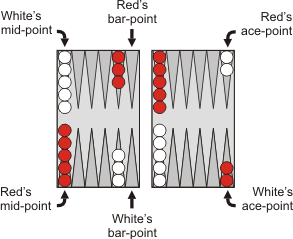
Q: Can I pass when it’s my turn?
No, you must play your roll if there is any legal way to do so. If you can’t play all of your numbers, you must play as many as you can. So if you roll 
Q: Is hit-and-run allowed (also known as “pick and pass”)?
Yes, if you hit a checker, you are allowed to run your hitter to safety. Here is an example:
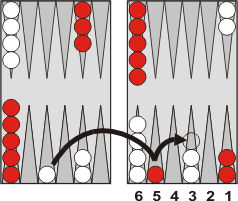
There are some variations of backgammon, played in the Middle East, where hit-and-run is not allowed in the player’s home board. But the standard game has no such restriction.
Q: What is a doubling cube?
A doubling cube is a cubical block, a little larger than a regular die, with the numbers 2, 4, 8, 16, 32, and 64 printed on its faces. It is sometimes simply called the cube. The purpose is to allow players to bet on the game as they are playing.

Q: How do you use a doubling cube?
At the beginning of the game, the doubling cube is placed halfway between the players, either on the bar or at the side of the board, with the number 64 face up. The 64 means that the stakes have not been doubled yet. (Most doubling cubes do not have a 1, so the number 64 is understood to represent 1) The position of the cube, halfway between the players, indicates that both players have access to it. That is, either player can make the first double.
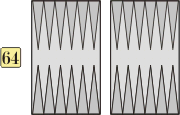
At any point during the game, a player who thinks they have a sufficient advantage may double the stakes. They can do this only at the beginning of their turn, before they have rolled the dice.
When a double is offered, the opponent may refuse the double, in which case they resign the game and forfeit the current stakes. The current stake is the value of the cube before the double is offered, in this case one point.
If the opponent doesn’t want to resign, they may accept the double, and agree to continue play at double the previous stakes. They place the cube on their side of the board with the number 2 face up. The number 2 represents the fact that the stakes are now doubled. The position of the cube means that player now owns the doubling cube and only they may make the next double.
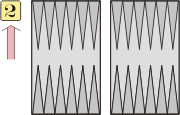
If the game later turns around and the player who owns the cube feels they now have an advantage, they may redouble the stakes to 4. Their opponent may refuse and give up the current stakes (now two units) or they may accept and continue play at quadruple the initial stakes.
There is no limit to the number of doubles and redoubles in a single game, except that no player may double twice in a row.
At the end of the game, the loser pays the winner the value of the doubling cube in whatever units they have agreed to play for. For example, if playing for one dollar a point and the doubling cube shows 4, then the loser pays the winner four dollars. In the case of a gammon or backgammon, this amount is doubled or tripled.
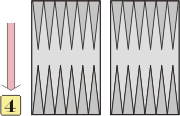
Yes, you can double at the start of any turn. You have to be alert, though; your opponent, seeing that you can’t move, may roll their dice without waiting to see what you do. Just ask them to “wait, please” as they pick up their dice while you decide whether or not to double.
Some people play that if the two players roll the same number on the first roll of the game, then the doubling cube is automatically turned to 2. The cube stays in the middle but now the first voluntary double of the game will be offered at 4. If the players roll the same number again, then the cube is turned up another notch, though players often agree to limit the number of automatic doubles to one per game.
Q: What is match play?
When backgammon tournaments are held to determine an overall winner, the usual style of competition is match play. Competitors are paired off, and each pair plays a series of games to decide which player progresses to the next round of the tournament. This series of games is called a match. Match play is also popular on backgammon play sites.Matches are played to a specified number of points. The first player to accumulate the required points wins the match. Points are awarded in the usual manner: 1 for a single game, 2 for a gammon, and 3 for a backgammon. The doubling cube is used, so the winner of each game receives the value of the game multiplied by the final value of the cube. Automatic doubles, beavers, and the Jacoby rule are not used in match play.
Q: What is the Crawford rule?
If you are playing a match up to n points and one player reaches n – 1 points, the Crawford rule says that the doubling cube is out of play for one game. This one game without doubling is called the Crawford game. After the Crawford game, the doubling cube is back in play again. The Crawford rule is a standard part of match play.
| Match to 5 | White Score | Black Score | ||
| Game 1: | White wins 2 points | 2 | 0 | Doubling Allowed |
| Game 2: | Black wins 1 point | 2 | 1 | Doubling Allowed |
| Game 3: | White wins 2 points | 4 | 1 | Doubling Allowed |
| Game 4: | Black wins 1 point | 4 | 2 | Crawford Game |
| Game 5: | Black wins 2 points | 4 | 4 | Doubling Allowed |
| Game 6: | White wins 2 points | 6 | 4 | Doubling Allowed |
In this example, White and Black are playing a 5-point match. After three games, White has 4 points, one short of what they need for the match. That triggers the Crawford rule, and no doubling is allowed in the next game, Game 4.
The idea behind the rule is that without restrictions on doubling, the player who is behind in the match would double at their first opportunity every game. This reduces the number of games needed to win the match, lessening the value of the points held by the player who is winning. On the other hand, if the cube were taken out of play completely, the player who is behind in the match would have to win all their remaining points without any help from the doubling cube at all. The Crawford rule is an intelligent compromise. The Crawford rule was devised by John R. Crawford, co-author of The Backgammon Book.
Q: What is a chouette?
Chouette is a social form of backgammon for three or more players. One player, the box, plays on a single board against all the others who form a team lead by a captain.
To determine the order of play, players each throw one die, and rerolls are used as needed to break ties. The player rolling highest becomes the box; second highest becomes the captain of the team playing against the box. The captains plays for the team, and has the final say on all checker-play decisions.
When the box wins a game, they collect from each team member and retains their position as the box. The captain goes to the back of the line and the next player on the team becomes the new captain.
When the team wins a game, the box pays off to each team member and goes to the end of the line. The captain becomes the new box, and the next player in line becomes the new captain.
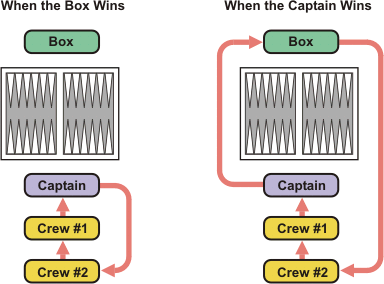
Q: What is a multiple-cube chouette?
A chouette may be played with either a single doubling cube or multiple cubes. In a single-cube game, the only decision that the members of the team make individually concerns takes. If the box doubles, each team member can decide on their own whether to play on or drop out. Those who drop out each pay off to the box and no longer participate as team advisers. If the captain drops out while there are others on the team who wish to play on, the captaincy is assumed by one of these players and the previous captain drops to the bottom of the rotation.
Most chouettes today use multiple cubes. Each member of the team has their own doubling cube. The box can double the individual team members, and each team member can decide whether and when to double the box. With multiple cubes in play, it is possible for the box to win against some players while losing against others. So the question arises, when does a player get to keep the box? The usual rule is that a player retains the box if they defeat the captain.
Q: When is consulting allowed?
Customs vary as to the rights of the team. In some chouettes, they may consult freely as to how rolls should be played. Too much consulting, however, can really slow the game down, so many chouettes ban consulting. A popular compromise permits consultation only after the cube has been turned.



